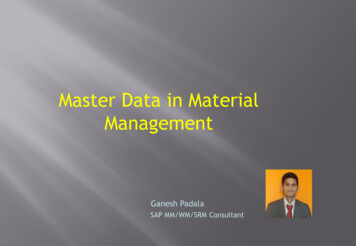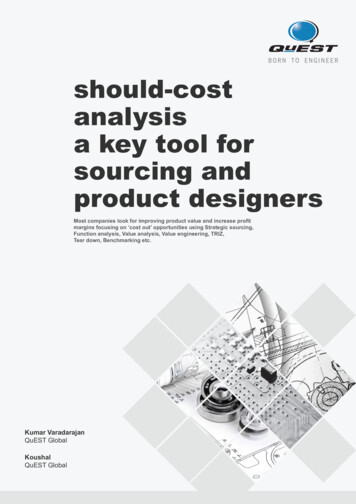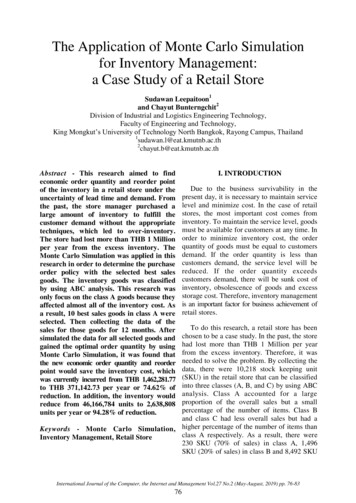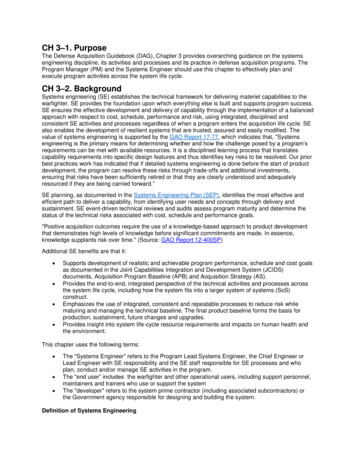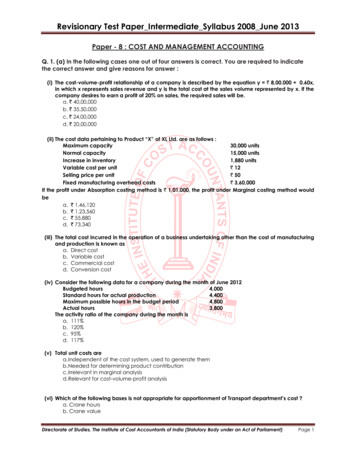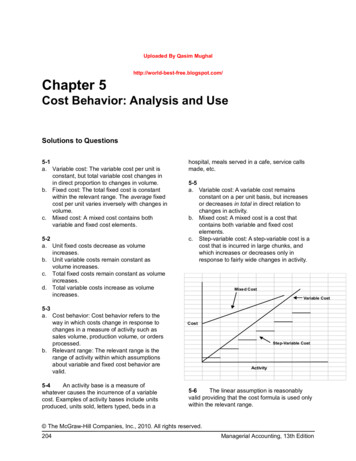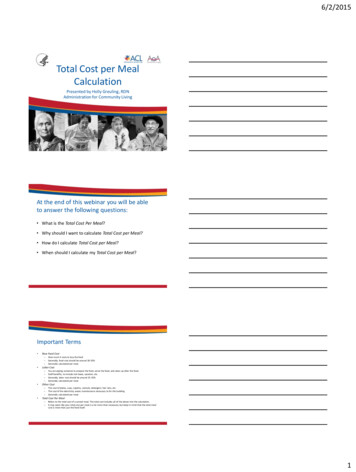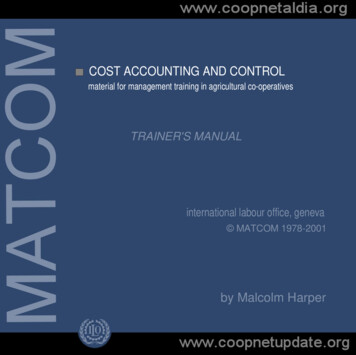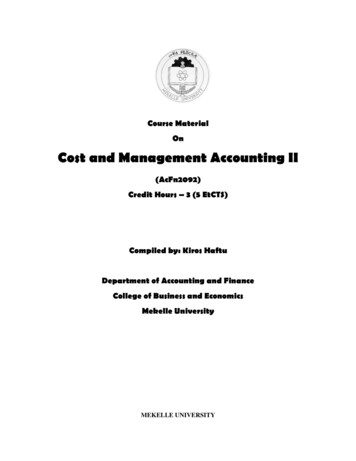
Transcription
Course MaterialOnCost and Management Accounting II(AcFn2092)Credit Hours – 3 (5 EtCTS)Compiled by: Kiros HaftuDepartment of Accounting and FinanceCollege of Business and EconomicsMekelle UniversityMEKELLE UNIVERSITY
COLLEGE OF BUSINESS AND ECONOMICSDEPARTMENT OF ACCOUNTING AND FINANCE PROGRAMCourse InformationCourse CodeCourse TitleDegree ProgramModuleInstructor’sInformationETCTS CreditsContact Hours (per week)Course ObjectivesAcFn 2092Cost and Management Accounting –IIBA Degree in Accounting and FinanceCost and managerial accounting53After successfully completing this course, the students should be able to: Explain the importance of cost- volume- profit analysis; Describe the benefit of budgeting and its application; Prepare a master budget; Prepare a flexible budget; Compute and interpret variances; Apply relevant costing to different decisions; Explain the methods of pricing; Explain the costs and benefits of decentralization.Course DescriptionThe course builds on the knowledge acquired from the course entitled cost andManagement Accounting and introduces some new concepts and uses of accounting toolsand techniques in the analysis, planning and control of business operations andmanagement decision making processes. Topics covered include: Intensive review of themanagement decision making processes and nature of management information,examination of concepts and rationale underlying managerial accounting, managerialmethods, the budgeting process and standard costing, the investment decision andquantitative methods of evaluation.WEEKS2WEEK{1ST&2NDCourse Contents1. Cost-Volume-Profit Relationships1.1. Variable and fixed cost behavior and patterns1.2. Break-even analysis uses and techniques1.3. Planning with cost-volume-profit Data1.4. Limitation of CVP analysis2 WEEKS{3RD&4TH}2. The Master Budget2.1. The overall plan and its characteristics2.2. Advantages of budgeting2.3. Types of budgets2.4. Developing the master budget2.5. Difficulties of sales forecasting3WEEKS{5TH,6TH&7TH}3. Flexible Budgets and Standards3.1. Static vs. Flexible budgets3.2. Standards for material and labor3.3. Controllability and variance analysis3.3.1. Direct material3.3.2. Direct labor,3.4. Overheads
3WEEKS{8TH,9TH&10TH}4. Measuring Mix and Yield Variances4.1. Sales variances4.1.1. Sales volume variance4.1.2. Sales Mix Variance4.1.3. Market-size and market-share variance.4.2. Input variances4.2.1. Direct materials Mix and Yield Variances4.2.2. Direct Labor Mix and Yield variances4.3. Productivity Measurement3 WEEKS{11TH,12TH&13TH}5. Decision-making and Relevant Information5.1. The role of Accounting in special decisions5.2. The meaning of relevance5.3. Irrelevance of past costs and future costs that will not differ5.4. Special decision areas5.4.1. Make or Buy decision5.4.2. Special Order decisions5.4.3. Add or Drop decisions5.4.4. Product Mix decisions5.4.5. Scarce Resource decisions2WEEKS{13TH&14TH}6. Pricing Decisions and Cost Management6.1. Major influence on pricing decisions6.2. Costing and pricing for the short run and long run.6.3. Cost plus target rate of return on investment7. Decentralization and Transfer Pricing7.1. Decentralization7.2. Responsibility Center7.3. Transfer Price1 WEEKS{16TH}Roles of the studentsThe success of this course depends on the students’ individual and collective contributionto the class discussions. Students are expected to participate voluntarily, or will be calledupon, to contribute to set exercises and problems. Students are also expected to read theassigned readings and prepare the cases before each class so that they could contributeeffectively to class discussions. Students must attempt assignments by their own.Proficiency in this course comes from individual knowledge and understanding. Copyingthe works of others is considered as serious offenses and leads to disciplinary actions.Assessment/EvaluationText andbooksContineous tests for esch chapterAssignmentsTerm paper (industry assessments, as needed)Final examreference Text Book:Horngren, Datar & Rajan. Cost Accounting: A Managerial Emphasis, 14th Ed. 2012Reference BooksGarison. Noreen and Brewer, Managerial Accounting, 13th Ed. 2010Gray and Ricketts; “Cost and Managerial Accounting”Heltger and Matulich; “Managerial Accounting”Moore - Jaedicke- Anderson; “Managerial Accounting”
CHAPTER ONECOST-VOLUME-PROFIT RELATIONSHIPSVariable and fixed cost behaviour and patternsCost behavior refers to how a certain cost will behave in response to a change in level of activity. Forplanning purposes, a manager must be able to anticipate which of these will happen; and if a cost can beexpected to change, the manager must know by how much it will change. To help make such distinctions,costs are often characterized as variable, fixed, or mixed.Variable Cost:A variable cost is a cost that varies, in total, in a direct proportion to changes in the level of activity. Theactivity can be expressed in many ways, such as, units produced, units sold, miles driven, beds occupied,hours worked and so forth. Direct material is a good example of a variable cost. The variable cost isconstant if expressed on a per unit basis.Fixed Cost:A fixed cost is a cost that remains constant, in total, regardless of changes in the level of activity. Unlikevariable costs, fixed costs are not affected by changes in activity. Consequently, as the activity level risesand falls, the fixed costs remain constant in total amount unless influenced by any outside forces, such asprice changes. Rent is a good example of fixed cost. Average fixed cost per unit increases and decreasesinversely with changes in activity.Mixed/Semi Variable CostA mixed cost is one that contains both variable and fixed cost elements together. Mixed cost is also knownas semi variable cost. Examples of mixed costs include electricity, water and telephone bills. The rentpaid for the line or counter is a fixed cost, the kilowatt hour or number of calls payment is a variable costas payment varies with usage.Cost-volume-profit analysisCost-volume-profit analysis examines the behaviour of total revenues, total costs, and operating profit aschanges occur in the output level, selling price, variable costs per unit, or fixed costs.
Managers use cost-volume-profit (CVP) analysis to identify the levels of operating activity needed to avoidlosses, achieve targeted profits, plan future operations, and monitor organizational performance.Accountants often perform CVP analysis to plan future levels of operating activity and provide informationabout: Which products or services to emphasize The volume of sales needed to achieve a targeted level of profit The amount of revenue required to avoid losses Whether to increase fixed costs How much to budget for discretionary expenditures Whether fixed costs expose the organization to an unacceptable level of riskProfit Equation and Contribution MarginCVP analysis begins with the basic profit equation.Profit Total revenue -Total costsSeparating costs into variable and fixed categories, we express profit as:Profit Total revenue - Total variable costs -Total fixed costsContribution margin indicates why operating income changes as the number of units sold changes. Thecontribution margin is total revenue minus total variable costs. Similarly, the contribution margin perunit is the selling price per unit minus the variable cost per unit. Both contribution margin andcontribution margin per unit are valuable tools when considering the effects of volume on profit.Contribution margin per unit tells us how much revenue from each unit sold can be applied towards fixedcosts. Once enough units are sold to cover all fixed costs, then the contribution margin per unit from allremaining sales becomes profit.Expressing CVP RelationshipsThere are three related methods to deal with the model CVP relationships:1. The equation method2. The contribution margin method3. The graph methodThe equation method and the contribution margin method are most useful when managers want todetermine operating income at few specific levels of sales (for example 5, 15, 25, and 40 units sold). Thegraph method helps managers visualize the relationship between units sold and operating income over awide range of quantities of units sold. However, different methods are useful for different decisions.
1. Equation MethodRevenues - Variable costs - Fixed costs Operating incomeNote:*Revenues Selling price (SP) Quantity of units sold (Q)*Variable costs Variable cost per unit (VCU) Quantity of units sold (Q)Thus:(SP Q) – (VCU Q) – fixed cost operating income .Equation 1Equation 1 becomes the basis for calculating operating income for different quantities of units sold.2. Contribution Margin MethodRearranging equation 1,(SP-VCU) (Q) – fixed cost operating income (Contribution margin Q) – fixed cost operating income Equation 23. Graph MethodIn the graph method, we represent total costs and total revenues graphically. Each is shown as a line on agraph.Total costs line. The total costs line is the sum of fixed costs and variable costs. In this example the totalcosts line is the straight line from point A through point B.Total revenue line. One convenient starting point is 0 revenues at 0 units sold, which is point C. Selecta second point by choosing any other convenient output level and determining the corresponding totalrevenues. The total revenue line is the straight line from point C through point D.Profit or loss at any sales level can be determined by the vertical distance between the two lines at thatlevelY(dollars)8000total revenue lineDoperating income areaB operating incometotal cost line6000Variable cost5000operating loss areabreakeven point40002000Afixed cost
C102025304050 X(unit sold)Cost-Volume-Profit AssumptionsCPV analysis to be applied, there are assumptions including:1. Changes in the levels of revenues and costs arise only because of changes in the number ofproducts (or service) or units sold. The number of units sold is the only revenue driver and theonly cost driver.2. Total costs can be separated into two components: a fixed component that does not vary withunits sold and a variable component that changes with respect to units sold.3. When represented graphically, the behaviors of total revenues and total costs are linear (meaningthey can be represented as a straight line) in relation to units sold within a relevant range (andtime period).4. Selling price, variable cost per unit, and total fixed costs (within a relevant range and time period)are known and constant.An important feature of CVP analysis is distinguishing fixed from variable costs. Always keep in mind,however, that whether a cost is variable or fixed depends on the time period for a decision. The shorterthe time horizon, the higher the percentage of total costs considered fixed. Always consider the relevantrange, the length of the time horizon, and the specific decision situation when classifying costs as variableor fixed.Break Even Point and Target Operating IncomeThe breakeven point (BEP) is that quantity of output sold, at which total revenues equal total costs, thatis, the quantity of output sold that results in 0 of operating income.Example:If the company sold one unit at 200, variable cost per unit 120, and also fixed cost is 2,000, what willbe the amount of break-even quantity? Recall the equation method (equation 1):(SP Q) – (VCU Q) – fixed cost operating income ( 200 Q) - ( 120 Q) - 2,000 0 80 Q 2,000 Q 2,000 80 per unit 25 unitsInterpretation:
If the company sells fewer than 25 units, it will incur a loss; if it sells 25 units, it will be at breakeven; andif it sells more than 25 units, it will make a profit. While this breakeven point is expressed in units, it canalso be expressed in revenues (Dollar): 25 units 200 selling price 5,000. Recall the contribution margin method (Equation 2):(Contribution margin Q) – fixed cost operating income,Since at break even, operation income is zero (0),*Contribution margin per unit Breakeven number of units Fixed cost .Equation 3Rearranging Equation 3 and entering the data,Breakeven number of units Fixed cost contribution margin per unit 2,000 80 25 unitsBreakeven revenues Breakeven number of units Selling price 25 units 200 per unit 5,000In practice (because they have multiple products), companies usually calculate breakeven point directly interms of revenues using contribution margin percentages.Contribution margin percentage Contribution margin per unitSelling price 80 0.4 or 40% 200That is, 40% of each dollar of revenue, or 40 cents, is contribution margin. To breakeven, contributionmargin must equal fixed costs of 2,000. To earn 2,000 of contribution margin, when 1 of revenueearns 0.40 of contribution margin, revenues must equal 2,000 0.40 5,000.While the breakeven point tells managers how much they must sell to avoid a loss, managers are equallyinterested in how they will achieve the operating income targets underlying their strategies and plans.Target Operating IncomeWe illustrate target operating income calculations by asking the following question:How many units must the company sell to earn an operating income of 1,200 based on the aboveexample? One approach is to keep plugging in different quantities and check when operating incomeequals 1,200. The result shows that operating income is 1,200 when 40 packages are sold. A moreconvenient approach is to use equation 1.(SP Q) – (VCU Q) – fixed cost operating income . Equation 1We denote by Q the unknown quantity of units the company must sell to earn an operating income of 1,200. The selling price is 200, variable cost per package is 120, fixed costs are 2,000, and targetoperating income is 1,200. Substituting these values into equation 1, we have:( 200 * Q) - ( 120 * Q) - 2,000 1,200 80 * Q 2,000 1,200 3,200
Q 3,200 per unit 40 units 80Alternatively, we could use Equation 2,(Contribution margin Q) – fixed cost operating income Equation 2Given a target operating income ( 1,200 in this case), we can rearrange terms to get Equation 4.Q Fixed costs Target operating income ., .Equation 4Contribution margin per unitQ 2,000 1,200 80 per unit 40 unitsThe revenues needed to earn an operating income of 1,200 can also be calculated directly by recognizing(1) that 3,200 of contribution margin must be earned (fixed costs of 2,000 plus operating income of 1,200) and (2) that 1 of revenue earns 0.40 (40 cents) of contribution margin. To earn 3,200 ofcontribution margin, revenues must equal 3,200 0.40 8,000.Target Net Income and Income TaxesNet income is operating income plus non-operating revenues (such as interest revenue) minus nonoperating costs (such as interest cost) minus income taxes. For simplicity, throughout this chapter weassume non-operating revenues and non-operating costs are zero. Thus,Net income Operating income - Income taxesIn many companies, the income targets for managers in their strategic plans are expressed in terms of netincome. That’s because top management wants subordinate managers to take into account the effects theirdecisions have on operating income after income taxes. Some decisions may not result in large operatingincomes, but they may have favorable tax consequences, making them attractive on a net income basis—the measure that drives shareholders’ dividends and returns.To make net income evaluations, CVP calculations for target income must be stated in terms of target netincome instead of target operating income. For example, the company may be interested in knowing thequantity of units it must sell to earn a net income of 960, assuming an income tax rate of 40%.Target net income (target operating income) – (target operating income tax rate) target operating income (1 – tax rate)Target operating income Target net income1 - Tax rate 960 1,6001- 0.40The key step is to take the target net income number and convert it into the corresponding targetoperating income number. We can then use Equation 1 for target operating income and substitutenumbers from our previous example.( 200 * Q) - ( 120 * Q) - 2,000 1,600 80 * Q 3,600
Q 3,600/ 80 per unit 45 units: Quantity of units required to be soldFocusing the analysis on target net income instead of target operating income will not change thebreakeven point. That’s because, by definition, operating income at the breakeven point is 0, and noincome taxes are paid when there is no operating income.Using CVP Analysis for Decision MakingManagers also use CVP analysis to guide other decisions, many of them strategic decisions. Consider adecision about choosing additional features for an existing product. Different choices can affect sellingprices, variable cost per unit, fixed costs, units sold, and operating income. CVP analysis helps managersmake product decisions by estimating the expected profitability of these choices.Strategic decisions invariably entail risk. CVP analysis can be used to evaluate how operating income willbe affected if the original predicted data are not achieved—say, if sales are 10% lower than estimated.Evaluating this risk affects other strategic decisions a company might make. For example, if theprobability of a decline in sales seems high, a manager may take actions to change the cost structure tohave more variable costs and fewer fixed costs.We return to our previous example to illustrate how CVP analysis can be used for strategic decisionsconcerning advertising and the selling price.1. Decision to AdvertiseSuppose the company anticipates selling 40 units at the fair. The data indicate that the company’soperating income will be 1,200. It is considering placing an advertisement describing the product and itsfeatures in the fair brochure. The advertisement will be a fixed cost of 500. It thinks that advertising willincrease sales by 10% to 44 packages. Should the company advertise? The following table presents theCVP analysis.40 PackagesSold withNo Advertising(1)44 PackagesSold withAdvertising(2)Difference(3) (2) - (1)Revenues ( 200 * 40; 200 * 44) 8,000 8,800 800Variable costs ( 120 * 40; 120 * 44)4,8005,280480Contribution margin ( 80 * 40; 80 * 44)3,2003,520320Fixed costs2,0002,500500Operating income 1,200 1,020 (180)Decision: Operating income will decrease from 1,200 to 1,020, so it should not advertise.2. Decision to Reduce Selling Price
Having decided not to advertise, the company is contemplating whether to reduce the selling price to 175. At this price, they think that they will sell 50 units. At this quantity, the package wholesaler whosupplies the product will sell the packages to it for 115 per unit instead of 120. Should the companyreduce the selling price?Contribution margin from lowering prices to 175: ( 175 - 115) per unit * 50 units 3,000Contribution margin from maintaining price at 200: ( 200 - 120) per unit * 40 units . 3,200Change in contribution margin from lowering prices . (200)Decreasing the price will reduce the contribution margin by 200 and, because the fixed costs of 2,000will not change, it will also reduce operating income by 200. The company should not reduce the sellingprice.Sensitivity Analysis and Margin of SafetySensitivity analysis is a “what-if” technique that managers use to examine how an outcome will change ifthe original predicted data are not achieved or if an underlying assumption changes. In the context of CVPanalysis, sensitivity analysis answers questions such as, “What will operating income be if the quantity ofunits sold decreased by 5% from the original prediction?” and “What will operating income be if thevariable cost per unit increases by 10%?” Sensitivity analysis broadens managers’ perspectives topossible outcomes that might occur before costs are committed.The margin of safety answers the “what-if” question: If budgeted revenues are above breakeven anddrop, how far can they fall below budget before the breakeven point is reached? Sales might decrease as aresult of a competitor introducing a better product, or poorly executed marketing programs, and so on.Margin of safety Budgeted (or actual) revenues - Breakeven revenuesMargin of safety (in units) Budgeted (or actual) sales quantity - Breakeven quantityAssume that the company has fixed costs of 2,000, a selling price of 200, and variable cost per unit of 120. If the company sells 40 units, budgeted revenues are 8,000 and budgeted operating income is 1,200. The breakeven point is 25 units or 5,000 in total revenues.Margin of safety budgeted revenues - breakeven revenues 8000 - 5000 3,000Margin of safety (in units) Budgeted sales unit - Breakeven sales unit 40 – 25 15 unitsMargin of safety percentage Margin of safety in dollars 3,000 37.5%Budgeted (or actual) revenues 8,000This result means that revenues would have to decrease substantially, by 37.5%, to reach breakevenrevenues. The high margin of safety gives the company confidence that they are unlikely to suffer a loss.
Sensitivity analysis is a simple approach to recognizing uncertainty, which is the possibility that an actualamount will deviate from an expected amount. Sensitivity analysis gives managers a good feel for therisks involved.Cost Planning and CVPManagers have the ability to choose the levels of fixed and variable costs in their cost structures. This is astrategic decision. The followings are various factors that managers and management accountantsconsider as they make this decision.a. Alternative Fixed-Cost/Variable-Cost StructuresCVP-based sensitivity analysis highlights the risks and returns as fixed costs are substituted for variablecosts in a company’s cost structure.Number of units required to be sold at 200 sellingPrice to earn target operating income ofFixed CostVariable Cost 0 (Breakeven point) 2,000Line 6 2,000 1202550Line 11 2,800 1002848Compared to line 6, line 11, with higher fixed costs, has more risk of loss (has a higher breakeven point)but requires fewer units to be sold (48 versus 50) to earn operating income of 2,000. CVP analysis canhelp managers evaluate various fixed-cost/variable-cost structures.b. Operating LeverageThe risk-return trade-off across alternative cost structures can be measured as operating leverage.Operating leverage describes the effects that fixed costs have on changes in operating income as changesoccur in units sold and contribution margin. Organizations with a high proportion of fixed costs in theircost structures have high operating leverage. Small increases in sales lead to large increases in operatingincome. Small decreases in sales result in relatively large decreases in operating income, leading to agreater risk of operating losses.At any given level of sale, Degree of operating leverage Contribution marginOperating incomeEffects of Sales Mix on IncomeSales mix is the quantities (or proportion) of various products (or services) that constitute total unit salesof a company. Suppose XYZ Co. is now budgeting for a subsequent college fair in New York. It plans tosell two different test-prep packages—GMAT Success and GRE Guarantee—and budgets the following:GMAT SuccessExpected salesRevenues, 200 and 100 per unit60 12,000GRE Guarantee40 4,000Total100 16,000
Variable costs, 120 and 70 per unit7,2002,80010,000Contribution margin, 80 and 30 per unit 4,800 1,2006,000Fixed costs4,500Operating income 1,500What is the breakeven point?In contrast to the single-product (or service) situation, the total number of units that must be sold to breakeven in a multiproduct company depends on the sales mix—the combination of the number of units ofGMAT Success sold and the number of units of GRE Guarantee sold. We assume that the budgeted salesmix (60 units of GMAT Success sold for every 40 units of GRE Guarantee sold, that is, a ratio of 3:2)will not change at different levels of total unit sales. That is, we think of XYZ co selling a bundle of 3units of GMAT Success and 2 units of GRE Guarantee. (Note that this does not mean that XYZ co.Physically bundles the two products together into one big package.) Each bundle yields a contributionmargin of 300 calculated as follows:Number of Units ofGMAT Success andGRE Guarantee inEach BundleContributionMargin per Unitfor GMAT Successand GRE GuaranteeContribution Marginof the BundleGMAT Success3 80 240GRE Guarantee23060Total 300To compute the breakeven point, we calculate the number of bundles XYZ co. needs to sell.Break even point in bundles Fixed cost 4500 Contribution margin per bundle300 per bundleBreakeven point in units of GMAT Success and GRE Guarantee is as follows:15 bundlesGMAT Success: 15 bundles * 3 units of GMAT Success per bundle 45 unitsGRE Guarantee: 15 bundles * 2 units of GRE Guarantee per bundle 30 unitsTotal number of units to break even 75 unitsBreakeven point in dollars for GMAT Success and GRE Guarantee is as follows:GMAT Success: 45 units * 200 per unit 9,000GRE Guarantee: 30 units * 100 per unit 3,000Breakeven revenues . 12,000When there are multiple products, it is often convenient to use contribution margin percentage.Under this approach, XYZ Co. first calculates the revenues from selling a bundle of 3 units of GMATSuccess and 2 units of GRE Guarantee:Number of UnitsSelling PriceOf GMAT Successfor GMAT SuccessAnd GRE Guaranteeand GRE GuaranteeIn Each BundleRevenue of the BundleGMAT Success3 200 600
GRE GuaranteeTotal2100Contribution margin percentage Contribution margin of the bundleFor the bundleRevenue of the bundle200 800 300 0.375 or 37.5%800Breakeven Fixed costsRevenuesContribution margin % for the bundle 4,500 12,0000.375Number of bundlesRequired to be soldTo break even 12,000 800 per bundle Breakeven revenuesRevenue per bundle 15 bundlesThe breakeven point in units and dollars for GMAT Success and GRE Guarantee are as follows:GMAT Success: 15 bundles * 3 units of GMAT Success per bundle 45 units 200 per unit 9,000GRE Guarantee: 15 bundles * 2 units of GRE Guarantee per bundle 30 units 100 per unit 3,000Recall that in all our calculations we have assumed that the budgeted sales mix (3 units of GMAT Successfor every 2 units of GRE Guarantee) will not change at different levels of total unit sales.Dear students:We prepare exercises to work on and check yourself whether you understand and grasp the main points ofthe chapter.EXERCISES FOR CHAPTER ONE1.The Express Banquet has two restaurants that are open 24-hours a day. Fixed costs for the tworestaurants together total 459,000 per year. Service varies from a cup of coffee to full meals. Theaverage sales check per customer is 8.50. The average cost of food and other variable costs for eachcustomer is 3.40. The income tax rate is 30%. Target net income is 107,100.A. Compute the revenues needed to earn the target net income.B. How many customers are needed to break even? To earn net income of 107,100?C. Compute net income if the number of customers is 170,000.2. Suppose Doral Corp.’s breakeven point is revenues of 1,100,000.Fixed costs are 660,000.A. Compute the contribution margin percentage. RequiredB. Compute the selling price if variable costs are 16 per unit.C. Suppose 95,000 units are sold. Compute the margin of safety in units and dollars.3. Garrett Manufacturing sold 410,000 units of its product for 68 per unit in 2011.Variable cost per unitis 60 and total fixed costs are 1,640,000.A. Calculate: (i) contribution margin and (ii) operating income.B. Garrett’s current manufacturing process is labor intensive. Kate Schoenen, Garrett’s productionmanager, has proposed investing in state-of-the-art manufacturing equipment, which will increase theannual fixed costs to 5,330,000. The variable costs are expected to decrease to 54 per unit. Garrett
expects to maintain the same sales volume and selling price next year. How would acceptance ofSchoenen’s proposal affect your answers to (i) and (ii) in requirement A?C. Should Garrett accept Schoenen’s proposal? Explain.4. Color Rugs are holding a two-week carpet sale at Jerry’s Club, a local warehouse store. Color Rugsplans to sell carpets for 500 each. The company will purchase the carpets from a local distributor for 350 each, with the privilege of returning any unsold units for a full refund. Jerry’s Clubhas offered ColorRugs two payment alternatives for the use of space. Option 1: A fixed payment of 5,000 for the sale period Option 2: 10% of total revenues earned during the sales periodAssume Color Rugs will incur no other costs.A. Calculate the breakeven point in units for (a) option 1 and (b) option 2. RequiredB. At what level of revenues will Color Rugs earn the same operating income under either option?a. For what range of unit sales will Color Rugs prefer option 1?b. For what range of unit sales will Color Rugs prefer option 2?C. Calculate the degree of operating leverage at sales of 100 units for the two rental options.D. Briefly explain and interpret your answer to requirement 3.5. Data 1-2-3 is a top-selling electronic spreadsheet product.Data is about to release version 5.0. It divides its customers into two groups: new customers and upgradecustomers (those who previously purchased Data 1-2-3, 4.0 or earlier versions). Although the samephysical product is provided to each customer group, sizable differences exist in selling prices andvariable marketing costs:New CustomersUpgrade CustomersSelling price 275 100Variable costsManufacturing 35 35Marketing651001550Contribution margin 175 50The fixed costs of Data 1-2-3, 5.0 are 15,000,000. The planned sales mix in units is 60% new customersand40% upgrade customers.1. What is the Data 1-2-3, 5.0 breakeven poi
books Text Book: Horngren, Datar & Rajan. Cost Accounting: A Managerial Emphasis, 14th Ed. 2012 Reference Books Garison. Noreen and Brewer, Managerial Accounting, 13th Ed. 2010 Gray and Ricketts; “Cost and Managerial Accounting” Heltger and Matulich; “Managerial Accounting” Moore - Jae


